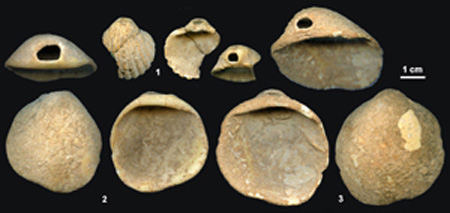For years, Darwinists claimed that apes were the supposed ancestors of man and that these were divided into various categories depending on their developmental characteristics. By establishing imaginary sequences such as Australopithecus, Homo habilis, Homo erectus, Neanderthal and Homo sapiens they attempted to give the impression that man gradually tried to walk upright, that his brain and abilities developed gradually and that he became more human as he left his ape-like characteristics behind. For years they strove to deceive people using imaginary pictures and reconstructions.
But like all deceptions, this has also come to an end. Recent statements about the Neanderthals in particular have made it essential to set out once more the following evidence regarding this human race that lived 200,000 years in the past and finally became extinct 60,000 years ago:
The Neanderthals were a human race, just like the human races of today. Speculation to the effect they were primitive was raised following the fraud perpetrated on the first Neanderthal fossil discovered, and although this claim has been refuted by the fossil record many times, the Darwinist dictatorship still insists on trying to keep it alive.
- Marcellin Boule, an evolutionist paleontologist examining a fossil said to belong to Neanderthal Man in the La Chapelle-aux-Saints region of France in 1908, maintained that these living things:
- Did not walk upright,
- Had a protruding forehead, and
- Were unable to speak because of the structure of their brains.
The Neanderthals were described as “primitive” on the basis of all these claims. But the speculation over this fossil was based on a huge fraud. Subsequent research into the fossil in question:
- Showed that the Neanderthal Man fossil discovered had a kind of joint infection, giving the knees and slightly bent appearance.
- More importantly, it emerged that the Darwinist paleontologist who investigated the fossil had deliberately portrayed it as walking with a stoop. Because the knee condition was no obstacle to Neanderthal Man walking upright.
- In addition, subsequent examinations of the fossil eliminated the Darwinist speculation about the Neanderthals’ speaking abilities. Studies showed that the structure of the Neanderthal throat and skull was completely compatible with speech.
Therefore, claims that the Neanderthals were primitive and unable to walk upright or to speak are a legacy left over from the fraudulent interpretation of this first Neanderthal to be found. All the Neanderthals discovered subsequently have been shown to have walked upright and to have a throat and vocal passage structure identical to that of man, just like that first Neanderthal.
Neanderthal characteristics refute Darwinists’ claims:
Neanderthals had strong and stocky bodies
- All the Neanderthal fossils found have strong and sturdy bodies. However, it is astonishing that Darwinists should depict this as a “primitive” trait. Because there are many stocky people alive today. It is as illogical to describe these people as primitive as it is to say the same thing about the Neanderthals. For example, one cannot say that tall Northwestern Europeans are cruder and more primitive than the smaller Chinese or pygmies. Because bone and skeletal structure are known not to be determining factors in behavior or intelligence.
- Neanderthals had narrow foreheads
- There are many human races today with narrow foreheads. This fact also therefore refutes the Darwinist claim of primitivism.
- Their skull volume was 13% greater than that of today’s man.
- The brain size of today’s man is 1500 cc, compared to 1700 cc in the Neanderthals. Darwinists’ own claim (that brain size increases and intelligence and abilities grow as evolution progresses), then this is sufficient to refute the claims regarding the Neanderthals. Yet intelligence, ability and the capacity for thought are known to be unrelated to brain size.
Neanderthals’ speech characteristics:
- Research into fossil remains has shown that the Neanderthal vocal cords were suited to producing all the sounds made by today’s man.
- Anatomic examination of skull fossils has confirmed this.
- According to researchers, since different sounds require different tongue movements, the human skull needs wider sub-lingual channels in order to carry wider tongue nerves. Investigations have shown that the Neanderthal channels were identical to those in today’s human beings.
- The researchers Richard Kay, Matt Cartmill and Michelle Balow made plastic models of the sub-lingual channels of three species of Australopithecus, two Neanderthal species, as well as those of chimpanzees, gorillas and human beings. (Earlier Human Speech, www.eurekalert.org/releases/DU-HuSp.html)
When they examined these models they observed that the channels in human beings were twice as wide as those in chimpanzees. Channels belonging to Australopithecus, a species of ape, had the same dimensions as apes, while those of Neanderthals possessed the same dimensions as human beings.
The latest findings regarding the Neanderthals refute evolutionist claims:
Neanderthals’ medical treatment techniques and ceremonies:
- Findings from caves inhabited by Neanderthals have provided important evidence that they were no different to today’s man. We know, for instance, that the Neanderthals treated the sick and injured and buried their dead with flowers. It is of course impossible for primitive beings to have such a social life style.


A Neanderthal needle and flute
- A needle and a flute made from bear bone belonging to the Neanderthals have been discovered. These important discoveries show that the human beings in question possessed an advanced conception of art and the concept of clothing.
Erik Trinkhaus, an expert on the Neanderthals, has made the following statements on the subject:
One of the most interesting Neanderthal discoveries is a flute made from a bear bone. The musicologist Bob Fink, who analysed this bone found in a cave in Northern Yugoslavia in 1995, established that the instrument produced four notes and had half and full tones. This discovery shows that the Neanderthals used the seven-note scale which forms the basis of Western music. ("Neandertals Lived Harmoniously," The AAAS Science News Service, April 3, 1997) Fink states that "the distance between the second and third holes on the old flute is double that between the third and fourth." This means that the first distance represents a full note, and the distance next to it a half note. Fink says, "These three notes … are inescapably diatonic and will sound like a near-perfect fit within any kind of standard diatonic scale, modern or antique," thus revealing that Neanderthals were people with an ear for and knowledge of music.[1]
A 26,000-year-old sewing needle, proved to have been used by Neanderthal people, was also found during fossil excavations. This needle, which is made of bone, is exceedingly straight and has a hole for the thread to be passed through.[2]

 Neanderthal decorative objects:
Neanderthal decorative objects:
- Steven L. Kuhn, a professor of archeology and anthropology at the University of New Mexico, and Mary C. Stiner spent years studying Neanderthal caves on the southwest coast of Italy and concluded that the Neanderthals engaged in activities requiring complex thought processes, like those of today’s man.[3]
- Finally, paleontologists from the University of Bristol discovered Neanderthal jewelry in 50,000-year-old caves in southern Spain. The Neanderthals used decorative objects made from sea shells and different pigments for coloring.
- A few years ago, German scientists revealed that the Neanderthals manufactured a sticky pitch made from tree resin. They scientists said that this would be a difficult task, requiring heating at temperatures of 400 degrees over several hours.
Other statement by Erik Trinkhaus, who spent years studying the Neanderthals, are as follows:
“Detailed comparisons of Neanderthal skeletal remains with those of modern humans have shown that there is nothing in Neanderthal anatomy that conclusively indicates locomotor, manipulative, intellectual, or linguistic abilities inferior to those of modern humans.”[4]
[1]The AAAS Science News Service, Neandertals Lived Harmoniously, 3 April 1997
[2]D. Johanson, B. Edgar, From Lucy to Language, p. 99, 107
[3]Trinkaus, E. and Shipman, P. The Neandertals, Alfred A. Knopf, New York, 399, 1992
[4]Erik Trinkaus, "Hard Times Among the Neanderthals", Natural History, Vol. 87, December 1978, p. 10; R. L.


